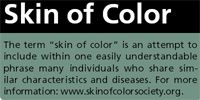- Acne
- Actinic Keratosis
- Aesthetics
- Alopecia
- Atopic Dermatitis
- Buy-and-Bill
- COVID-19
- Case-Based Roundtable
- Chronic Hand Eczema
- Chronic Spontaneous Urticaria
- Drug Watch
- Eczema
- General Dermatology
- Hidradenitis Suppurativa
- Melasma
- NP and PA
- Pediatric Dermatology
- Pigmentary Disorders
- Practice Management
- Precision Medicine and Biologics
- Prurigo Nodularis
- Psoriasis
- Psoriatic Arthritis
- Rare Disease
- Rosacea
- Skin Cancer
- Vitiligo
- Wound Care
Article
Cutaneous disease in skin of color surfaces as new, vital field of study
New York - Skin of color is an important, emerging field that dermatologists need to understand and become knowledgeable about, said Susan C. Taylor, M.D., speaking in the plenary session at the American Academy of Dermatology's (AAD) Academy'04.
New York - Skin of color is an important, emerging field that dermatologists need to understand and become knowledgeable about, said Susan C. Taylor, M.D., speaking in the plenary session at the American Academy of Dermatology's (AAD) Academy'04.

She says the term "skin of color" is an attempt to include within one easily understandable phrase many individuals share similar characteristics and diseases. However, it can further be used to bring together patients, clinicians and scientists interested in the investigation and treatment of a broad range of diseases affecting individuals with darker pigmented skin.
Information from studies on melanoma epidemiology and skin cancer prevention provides an excellent illustration of these racial-ethnic disparities as they pertain to skin disease, she says. More specifically, however, they also document that the need for skin cancer screening,prevention and treatment for the skin of color population appears to be undervalued.
The available data show that while the incidence of melanoma is lower in the skin of color population, when this malignancy occurs, it is more likely to be deadly and to be located on non-sun-exposed sites, present at an advanced stage. However, exceptions to that generalization exist within specific skin of color subpopulations. This demonstrates the principle that people with skin of color constitute a diverse group characterized by a range of racial and ethnic backgrounds, Dr. Taylor says.
For example, studies show there are epidemiological differences in melanoma among Hispanic individuals compared to those residing in the southwestern United States to those dwelling in the Southeast. Considering lesion location, stage at presentation and disease survival, the southwestern Hispanics appear to be more similar to blacks, whereas among Hispanics from the Southeast, those features are more reflective of disease characteristics in Caucasians.
"Those disparities may be explained by ancestral differences," says Dr. Taylor. "Hispanics living in the Southwest are predominantly Latinos of Mexican heritage, whereas in the Southeast, the Hispanic population is comprised more of descendants from Cuba, or Central or South American countries."
Focused message needed Other studies that have assessed such issues as skin cancer awareness, risk perception, performance of skin self-examinations, sunscreen use, and the likelihood of seeking immediate follow-up care for suspicious skin lesions highlight the existence of racial-ethnic differences in skin cancer detection/prevention behaviors and knowledge.
In terms of public health implications, those findings point to the need for health education messages specifically targeted to the skin of color population. Dr. Taylor cites the role of industry in public educational efforts and gives as a specific example the development of a patient education brochure by Beiersdorf entitled "Sun protection for skin of all colors."
"Recent data suggest that UVR exposure may have a greater than expected role in the development of melanoma in persons with skin of color, and yet these individuals may ignore multimedia skin cancer education campaign messages that often link warning signs and early detection strategies with sun-sensitive skin," Dr. Taylor says. "Therefore, it is important to develop culturally relevant messages that provide accurate information on risk factors, prevention, detection and treatment for skin cancer aswell as other serious dermatologic conditions."
Newsletter
Like what you’re reading? Subscribe to Dermatology Times for weekly updates on therapies, innovations, and real-world practice tips.













